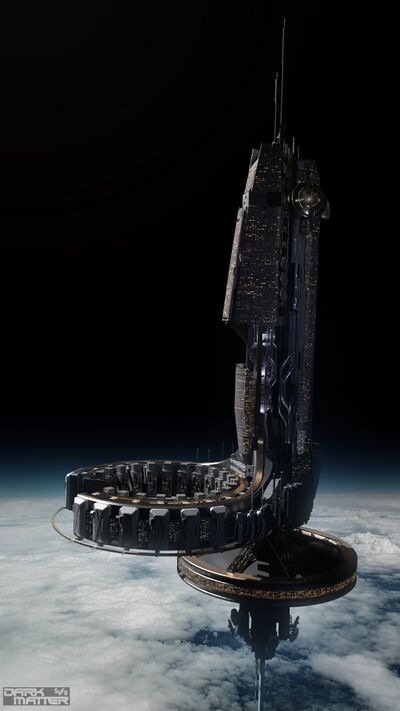Space Elevators (A1-0): Difference between revisions
No edit summary |
No edit summary |
||
| Line 1: | Line 1: | ||
''[[Infrastructures And Megastructures In The Galactyan Empire (A1-0)|<small><u>Go back to the main List</u></small>]]'' | ''[[Infrastructures And Megastructures In The Galactyan Empire (A1-0)|<small><u>Go back to the main List</u></small>]]'' | ||
Space Elevators are | Space Elevators are megastructures commonly used for the atmospheric transfer of maintenance ships and cargo streams. Space Elevators can either be '''dynamically supported structures''' rising from the surface, or they can be cables hanging from a '''geosynchronous anchorweight''', that acts as a smaller center for cargo during elevator-to-ship transfer.[[File:Beanstalk.jpg|thumb|711x711px|'''''A Geosynchronous Cable Elevator outiftted with a series of large maintenance probe holding pods and individual tracking bays.''''']][[File:Space Elevator-min-min.jpg|thumb|500x500px|'''''A Dynamically Supported Tower Elevator dedicated to a particularly large Cargo Stream on an expanding colony in the Middle Quadrants.'''''|left]] | ||
== '''Dynamically Supported Tower Elevators''' == | == '''Dynamically Supported Tower Elevators''' == | ||
A '''Dynamically Supported Tower Elevator''', also simply known as a '''Tower''', is a large tower-like structure similar in design to an ''Atlas Pillar''. Towers are constructed out of Diamondoid and Fullerene, and have their foundations burrowed deep into an artificial base for additional stability. They possess a series of internal tracks in which a pair of magnetically accelerated pellet streams run, one going upwards and one going downwards in a sort of loop, supporting the weight of the structure. These tracks are constructed out of lightly monopole-doped superconducting isolated materials, requiring little to no additional power input or cooling. At the top of a Tower is located a relatively small pressurized tracking and exchange chamber, in which cargo streams (and the occasional passengers) are automatically loaded onto ships. The '''Climber''' of a Tower is very similar to the Elevators in the Spaceport Pillars: they move using superconductive monopole-doped magnets with magnetic insulation in the inner chamber, to prevent interacting or damaging of the cargo goods. However, they still possess two carbon nanotube safety cables and an emergency gravity engine. Depending on the width of a Tower, anything from a singular central Climber to a series of radially arranged Climbers can be constructed. | A '''Dynamically Supported Tower Elevator''', also simply known as a '''Tower''', is a large tower-like structure similar in design to an ''Atlas Pillar''. Towers are constructed out of Diamondoid and Fullerene, and have their foundations burrowed deep into an artificial base for additional stability. They possess a series of internal tracks in which a pair of magnetically accelerated pellet streams run, one going upwards and one going downwards in a sort of loop, supporting the weight of the structure. These tracks are constructed out of lightly monopole-doped superconducting isolated materials, requiring little to no additional power input or cooling. At the top of a Tower is located a relatively small pressurized tracking and exchange chamber, in which cargo streams (and the occasional passengers) are automatically loaded onto ships. The '''Climber''' of a Tower is very similar to the Elevators in the Spaceport Pillars: they move using superconductive monopole-doped magnets with magnetic insulation in the inner chamber, to prevent interacting or damaging of the cargo goods. However, they still possess two carbon nanotube safety cables and an emergency gravity engine. Depending on the width of a Tower, anything from a singular central Climber to a series of radially arranged Climbers can be constructed. | ||
== '''Geosynchronous Cable Elevators''' == | == '''Geosynchronous Cable Elevators''' == | ||
A '''Geosynchronous Cable Elevator''', also known as a '''Beanstalk''', is a strong cable, usually made of Polybuckminsterfullerene or semi-elastic Diamondoid with a standard length of approximately '''36,000 kilometers''', lowered from a Geosynchronous moved natural or artificial satellite and anchored to the ground. Beanstalks have a counterweight at the outer end to provide some extra tension and stability, called an '''Anchorweight'''. Anchorweights are developed and used as habitat or docking nodes, or enclosed in a technic membrane and terraformed into habitable biomes. The '''Climber''' of a Beanstalk Elevator can be very varied in design, but they generally follow a similar shape and system: a torus shaped singular pod, or a series of radially arranged pods are attached to a central climbing engine (that can either be a mechanical motor employing offset traction-thread rollers, a monopole-doped supermagnetic climber coupled with a series of supermagnetic fullerene cables, or a combination of both), which accelerates and decelerates the Climber along the tether cable. The entirety of the climber, including the connecting plates, are covered in an additional layer of radiation shielding, either metallic or transparent, to allow for the large observation windows that are often present on the few non-cargo pods. | A '''Geosynchronous Cable Elevator''', also known as a '''Beanstalk''', is a strong cable, usually made of Polybuckminsterfullerene or semi-elastic Diamondoid with a standard length of approximately '''36,000 kilometers''', lowered from a Geosynchronous moved natural or artificial satellite and anchored to the ground. Beanstalks have a counterweight at the outer end to provide some extra tension and stability, called an '''Anchorweight'''. Anchorweights are developed and used as habitat or docking nodes, or enclosed in a technic membrane and terraformed into habitable biomes. The '''Climber''' of a Beanstalk Elevator can be very varied in design, but they generally follow a similar shape and system: a torus shaped singular pod, or a series of radially arranged pods are attached to a central climbing engine (that can either be a mechanical motor employing offset traction-thread rollers, a monopole-doped supermagnetic climber coupled with a series of supermagnetic fullerene cables, or a combination of both), which accelerates and decelerates the Climber along the tether cable. The entirety of the climber, including the connecting plates, are covered in an additional layer of radiation shielding, either metallic or transparent, to allow for the large observation windows that are often present on the few non-cargo pods. | ||
Revision as of 21:31, 16 December 2023
Space Elevators are megastructures commonly used for the atmospheric transfer of maintenance ships and cargo streams. Space Elevators can either be dynamically supported structures rising from the surface, or they can be cables hanging from a geosynchronous anchorweight, that acts as a smaller center for cargo during elevator-to-ship transfer.


Dynamically Supported Tower Elevators
A Dynamically Supported Tower Elevator, also simply known as a Tower, is a large tower-like structure similar in design to an Atlas Pillar. Towers are constructed out of Diamondoid and Fullerene, and have their foundations burrowed deep into an artificial base for additional stability. They possess a series of internal tracks in which a pair of magnetically accelerated pellet streams run, one going upwards and one going downwards in a sort of loop, supporting the weight of the structure. These tracks are constructed out of lightly monopole-doped superconducting isolated materials, requiring little to no additional power input or cooling. At the top of a Tower is located a relatively small pressurized tracking and exchange chamber, in which cargo streams (and the occasional passengers) are automatically loaded onto ships. The Climber of a Tower is very similar to the Elevators in the Spaceport Pillars: they move using superconductive monopole-doped magnets with magnetic insulation in the inner chamber, to prevent interacting or damaging of the cargo goods. However, they still possess two carbon nanotube safety cables and an emergency gravity engine. Depending on the width of a Tower, anything from a singular central Climber to a series of radially arranged Climbers can be constructed.
Geosynchronous Cable Elevators
A Geosynchronous Cable Elevator, also known as a Beanstalk, is a strong cable, usually made of Polybuckminsterfullerene or semi-elastic Diamondoid with a standard length of approximately 36,000 kilometers, lowered from a Geosynchronous moved natural or artificial satellite and anchored to the ground. Beanstalks have a counterweight at the outer end to provide some extra tension and stability, called an Anchorweight. Anchorweights are developed and used as habitat or docking nodes, or enclosed in a technic membrane and terraformed into habitable biomes. The Climber of a Beanstalk Elevator can be very varied in design, but they generally follow a similar shape and system: a torus shaped singular pod, or a series of radially arranged pods are attached to a central climbing engine (that can either be a mechanical motor employing offset traction-thread rollers, a monopole-doped supermagnetic climber coupled with a series of supermagnetic fullerene cables, or a combination of both), which accelerates and decelerates the Climber along the tether cable. The entirety of the climber, including the connecting plates, are covered in an additional layer of radiation shielding, either metallic or transparent, to allow for the large observation windows that are often present on the few non-cargo pods.